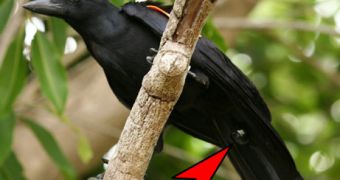Being birdbrained can sometimes suggest sheer intelligence. In lab tests, the New Caledonian crow outperformed even apes.
But new ultralight video cameras attached to their tail feathers allowed the researchers to follow the behavior of the highly intelligent tool-users in the wild. The first-of-its-kind research discovered that this bird employs a much wider array of tools and foraging techniques than previously known.
The crow's exceptional cognitive and tool-making abilities were known mainly from lab experiments, even if tool use was supposed to be common in wild specimens, too.
But observing the birds in the wild is hard, due to their dense forest habitat in the mountains of New Caledonia (off northeastern Australia) and high sensitivity to human presence.
But in the new research, tiny cameras, weighing just 13 grams (0.5-ounce), were attached to the Tails of individuals.
"The lens is pushed forward through the central tail feathers and peeks through the bird's legs. You have a shot showing part of the crow's belly and whatever appears in front of the bird," said lead researcher Christian Rutz of the University of Oxford in England.
This pilot study was mainly intended to check the new technology, but it came with surprising data on this species' natural behavior.
"With seven hours of video [from 12 individual crows] we made more new discoveries than in hundreds of hours of field observations," said Rutz.
The crows were known to "fish" for beetle grabs in dead wood using tools made from sticks or leaves, but the video recordings showed the crows also search extensively for food on the ground, employing a tool material previously unreported, stalks of grass, for digging on loose material while looking for insects.
"The fact that they use tools on the ground shows that the niche they exploit with their tool use is much larger than previously thought," said Rutz.
The crows did not always employ any kind of stick or stem to make a tool.
"In one instance, a favored tool was used over a prolonged period of time and carried in flight from one location to another." said Rutz.
Each tiny camera had a radio beacon permitting researchers to know the bird's location during and after shooting, for the camera to be retrieved.
"Testing on captive crows proved that the units could be easily carried and did not affect the birds' behavior," said Rutz.
"These guys have pushed the frontier in terms of identifying interesting research questions that can be addressed [through animal-mounted video] over fairly short periods of time. Because battery weight is a major constraint in ultralight video systems, cameras on birds cannot currently be deployed for periods of days or weeks," said researcher and filmmaker Greg Marshall, a pioneer in the use of animal-mounted video for research and the inventor of National Geographic's Crittercam. The team set the cameras to start shooting 48 hours after the installation and they recorded footage for 30 to 60 minutes before wasting the batteries.
"Very soon it will be possible to capture footage from really small species. I'm confident that in the next five years or so this will take off and become one of the standard techniques in field ornithology." said Rutz.
"Unfortunately, video tracking remains far out of reach on sparrows and other songbirds. [The system] will need to get down to around 300 to 600 milligrams [0.01 to 0.02 ounce] before I get to use it," said bird expert John Rotenberry at the University of California Riverside.

 14 DAY TRIAL //
14 DAY TRIAL //